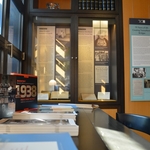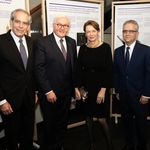Gerald Westheimer Fellows
- Autor
- David Brown
- Datum
- Do., 6. Nov. 2014
Thanks to the generosity of Professor Gerald Westheimer, LBI has supported fellowships for scholars who are early in their careers to pursue research on the social, cultural, and academic aspects of the life of Jews in German-speaking countries between the time of Moses Mendelssohn and the Third Reich and its aftermath. LBI is proud to introduce the Gerald Westheimer Career Development Fellows from 2013 – 2015.
2014-2015:
Samuel Spinner
The Museum of the Jews: Salvaging the primitive in German-Jewish and Yiddish literature
PhD Germanic Languages, Columbia University, 2013
Currently Postdoctoral Fellow, Yiddish Studies, Johns Hopkins University
The Museum of the Jews charts the presence of ethnographic and museal discourses in German and Yiddish literature, including the depiction of Hasidim as “savage tribesmen” by Franz Kafka, Alfred Döblin, and Joseph Roth, among others. The early twentieth-century crisis of identity and search for authenticity among German- and Yiddish-speaking Jews precipitated a turn to traditional, “primitive” Jews, exemplified by Martin Buber and Y.L. Peretz’s Hasidic stories. This literature shared much in common with broader European primitivism and its strains of Kulturkritik, which imagined the exotic savage as the paradigm for the recuperation of authenticity and the revitalization of society.
I argue, however, that the Jewish instantiation of primitivism presents a challenge to the standard scholarly model that describes primitivism as envisioning the infiltration of European society by the savage other—in Jewish primitivism, the savage is already there. This troubling of the boundary between observer and observed, savage and cultured, served to make Jews both subjects and objects of ethnography, placing European Jews and their literature at the center of the modern ethnographic project, namely the collection, salvage, and preservation of “primitive” cultures.
Stefanie Mahrer
Salman Schocken’s cultural project and the circle of German-Jewish intellectuals in the first half of the 20th century
PhD: Center for Jewish Studies, University of Basel, 2011
Currently: Post-doctoral fellow, Rosenzweig Minerva Center, Hebrew University of Jerusalem
Post-doctoral researcher, Center for Jewish Studies Basel University
This project focuses on Salman Schocken (1877 – 1959) and the network around him. In 1933, Schocken, a pioneer of modern department stores in Germany, was forced to leave his home country. In the year of the Schocken family’s emigration, Salman was not only the owner of a department store chain but also of a German-Jewish publishing house and was an important patron of German-Jewish intellectuals and writers, an influential cultural Zionist, and one of the most important book collectors of his time.
Recent academic biographies no longer look at the individual as an isolated being, but as a crossing point of social and structural influences. The biography as a genre permits the researcher to integrate different research questions, since it has a natural point of focus. Looking at Schocken thus allows us to address questions of forced migration and cultural transfer, as well as personal issues.
Thus, the main interest of this paper is to set out the alignment, function, mobility, and restoration of German-Jewish culture in Jerusalem after 1933. In the course of the fifth Aliyah, the cultural space of Jerusalem changed. A large number of German-Jewish intellectuals and writers migrated, most involuntarily, from German cities to Palestine, a lot of them to Jerusalem. It was not only the cultural space of Jerusalem that changed. German culture also had to find new forms in the new surroundings. We therefore have to ask how the GermanJewish cultural space was constituted from 1933 onwards beyond national borders, and what changes it underwent.
2013–2014:
Kerry Wallach
PhD Germanic Languages and Literatures, University of Pennsylvania, 2011
Currently Assistant Professor of German, Gettysburg College
Moments to be Seen: Gender and Jewish recognizability in Weimar Germany
This project builds on recent work in German-Jewish cultural studies and gender studies to underscore the significance of being or becoming recognizably Jewish, and of concealing Jewishness as necessary. It examines discourses of Jewish visibility and encounters (both between Jews, and between Jews and non-Jews) for which the discovery or identification of Jewishness became relevant. It does so through an exploration of sources including literature, memoirs, film, and articles in the Jewish press. Of particular interest are representations of how Jewishness became perceptible, and of how, when, and why different figures “came out” as Jewish, were “outed” by others, or opted to “pass” as non-Jewish.
Because Jewish women have been less visible as Jews throughout history—and, according to some scholars, are always only ambiguously identifiable as Jewish—there was a greater need for them to work at presenting outward expressions of Jewishness. Whereas others have argued in favor of a simple impulse for de-Judaization, secularization, or self-abnegation, this study maintains that there was in fact a pronounced desire for Jewish recognizability among Jews in Weimar Germany (1919 – 1933), and that gender played a central role in decisions about engaging with and displaying Jewishness. Further, many Jews cultivated a type of dual legibility that meant they could pass in some contexts and yet still be perceivably Jewish in others.
Ilse Josepha Lazaroms
PhD History & Civilization, European University Institute, Florence, Italy 2010
Currently Prins Foundation Fellow, Center for Jewish History
Revolutions of Thought and Sensibility: Hungarian-speaking Jewry in the years of rupture, 1900–1923
This project examines a crucial period in the history of Central European Jewry from an intersectional perspective, analyzing the changing narratives of Jewish national belonging during the three short decades from the late 1890s to the onset of early fascism in the 1920s.
In particular, it concentrates on the fate of Hungarianspeaking Jews, weaving together the viewpoints of anonymous and neglected historical actors into a study of upheaval, emigration, and the continuous desire to belong to a national homeland.
Analyzing the responses of Jews to the slow waning of emancipation that began around the turn of the century, and the increasing social and physical violence that accompanied this process, this project seeks to understand the relationship between social exclusion, violence, and narratives of national belonging from a decidedly oral and testimonial perspective.
Aktuelles





